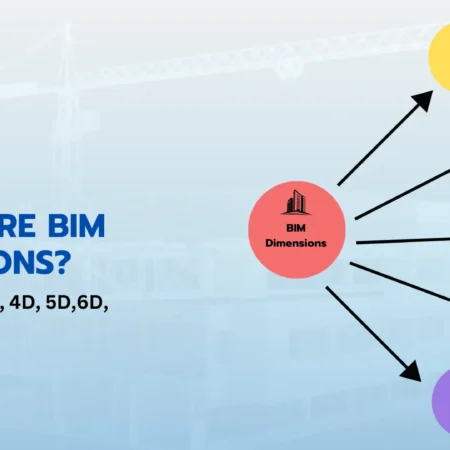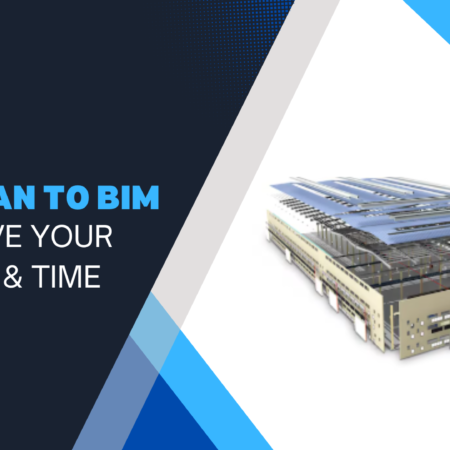
Have you ever wondered how complex architectural designs, that start as ideas, transition to functional structures? The answer is Building Information Modeling (BIM), a powerful tool that unites design and construction and how it can be incorporated to create positive change both in the workplace and in design and construction processes. This fundamental aspect of LOD in BIM determines how much information is present in a model throughout different stages of a project.
In this article, we’ll discuss BIM in terms of levels of detail and how they play a role in construction projects. This guide will be helpful to you no matter if you are a seasoned professional or are new to the field—whether you simply don’t understand LOD or need an introduction to it.
What is LOD in BIM?
Levels of Detail in BIM is the degree of precision and the amount of detail provided to 3D models as they pass through various stages of a project. Different LODs represent ways to share information about building components and systems. However, it plays a crucial role in BIM working, as you will see that it will affect the design, construction, and operation of every single aspect.
There are several stages of LOD: We range from simple geometric representations at LOD 100 to highly detailed models at LOD 400 and 500. In this system, architects, engineers, and contractors can work together effectively and ensure that each time there is the right information for each to make an informed decision.
The Origin of LOD:
Levels of Development were devised in the 1970s and have changed substantially since then. The need for a standardized language to specify the amount of detail in 3D models grew as capabilities of technology increased. Building Model Process (BMP) started the discussion about how the different parts of a building could be included in architectural models.
The American Institute of Architects (AIA) started formal definition of LOD in 2009 with the introduction of its BIM protocol. This made the expectation to understand the detail and information available at each stage of the lifecycle of a building project clearer. Understanding the history of LOD is vital for professionals as more and more of the industry adopts and embraces BIM in order to better collaborate and communicate.
The goal of this system is to ensure clear communication between architects, engineers, contractors, and owners so that expectations for the model’s detail are defined at various project stages. LOD in BIM can aid project efficiency, reduce errors, and lead to better decisions from the design phase through construction and even facility management.
BIM Levels of Development (LOD) Defined by AIA:
In the AIA framework, LOD is broken into five main levels, one for each main phase of the building’s life cycle. These levels define the progression of detail and data accuracy in a BIM model:
-
LOD 100 (Conceptual Design):
This model is basic in terms of geometric shapes and placeholders. Rough layout and massing studies are used to assess project feasibility. As an initial design discussion tool, LOD 100 is useful for giving you a general idea of the project without forcing you to nail down every detail. This stage allows stakeholders to evaluate the site at a high level and set project goals.
-
LOD 200 (Schematic Design):
The model inhere becomes more specific with approximate dimensions, spatial relations, and general locations. With sufficient accuracy, elements are modeled for early design decisions, cost estimates, and preliminary analysis. While the LOD 200 remains generic, it is much clearer about what the building will look like and how it will function, allowing stakeholder input into refining concepts and moving toward detailed design.
-
LOD 300 (Detailed Design):
The LOD 300 marks a big step forward in precision. Exact dimensions, materials, and spatial relationships are for components. This stage gives enough detail to achieve construction permits, prepare detailed drawings, and manage across disciplines. This agreement makes sure to build the model so that contractors can estimate the cost of the project and can prepare for the construction.
-
LOD 400 (Fabrication and Construction):
The model is enhanced with fabrication and assembly details at this level. It consists of manufacturing specifications as well as instructions for installation. LOD 400 supports actual construction, so that everything in the building can be constructed. This stage is critical to contractors’ precision resource allocation and on-site execution.
-
LOD 500 (As-Built Model):
The completed project is LOD 500. It consists of verified dimensions, materials, and specifications of the actually built construction. It is invaluable for facility management since it gives accurate data for maintenance and repairing and for future upgrades. The as-built model provides a facility to efficiently manage the building’s lifecycle.
The Role of LOD in BIM:
The Building Information Modeling (BIM) and the different LOCs and Development (LOD) are very important throughout the product life cycle. Here’s how LOD contributes at various stages:
- Enhanced Communication: With LOD, a project standardizes the information that stakeholders are sharing with each other, thereby reducing misunderstandings and ensuring everyone is working with the same set of facts. This promotes consistency and collaboration in the project lifecycle and better efficiency.
- Accurate Cost Estimation: It makes accurate material takeoff and cost estimating possible by specification of level of detail at that stage. This helps minimize cases where there are additional costs incurred that were not planned for, and people can view the accounts.
- Efficient Resource Allocation: It guarantees that the labor, materials, and equipment are assigned optimally. It reduces waste and makes sure the resources in use during a project are utilized properly.
- Informed Decision-Making: Benchmarks for detailed design and construction provide stakeholders clarity for informed design and planning decisions, lowering the risk of costly rework.
- Lifecycle Management: With LOD 500, the as-built model is detailed, and it is valuable for facility management. This allows for easy maintenance, streamlines renovations, and will guarantee the building’s longevity in the future.
Difference Between Level of Detail and Level of Development:
Although they are often used interchangeably, Level of Detail (LoD) and Level of Development (LOD) have distinct meanings. Here’s a detailed comparison:
| Aspect | Level of Development (LOD) | Level of Detail (LoD) |
|---|---|---|
| Meaning | Refers to how developed and accurate a building model or design is at a particular stage. | Refers to the amount of detail included in a design or model. |
| Purpose | Helps to define the stages of progress in creating a building model. | Ensures that the right amount of detail is added depending on the project needs. |
| Focus | Focuses on the progress or completeness of the design over time. | Focuses on how detailed each component of the model is, such as textures or specific features. |
| Application | Used throughout the design and construction process to measure how far along a project is. | Used to ensure that the model is detailed enough for its intended purpose, whether for visualization or construction. |
| Measurement | Measured by the level of information and accuracy in the model at each stage. | Measured by how detailed the model is, such as the resolution of textures or parts. |
| Stage Example | LOD 100 (conceptual) to LOD 500 (as-built). | Level of detail might range from a simple outline (low detail) to a fully textured, realistic model (high detail). |
| Audience | Project teams, including architects and engineers, use LOD to understand how complete the design is. | Visual designers and construction teams use LOD to ensure the model’s detail fits the task. |
By clearly distinguishing between these two aspects, stakeholders can ensure that their BIM models meet project-specific requirements effectively.
Conclusion:
LOD in BIM is an indispensable framework for the evolution of 3D models in the building lifecycle. It aligns expectations; it enhances collaboration, and it supports decision-making to ensure that projects are delivered on time, on budget, and at the highest quality. If you are an architect, engineer, or facility manager, understanding and applying LOD will greatly enhance your project outcomes.
FAQs:
- What is LOD (Level of Development) in BIM?
LOD specifies the level of detail and accuracy available for a BIM model from conceptual design (LOD 100) to as-built information (LOD 500). - What are the different levels of LOD in BIM?
- LOD 100: Conceptual design.
- LOD 200: Approximate geometry.
- LOD 300: Precise geometry.
- LOD 400: Construction details.
- LOD 500: As-built model.
- Why is LOD important in BIM?
Lod ensures that the base of detail is exactly right at each phase of the project to improve communication, decrease errors, and speed up projects. - How does LOD impact project costs and timelines?
Errors caused by BIM using inadequate LOD can be decreased by 30-40%, saving costs and making deliveries on time. - Is there a statistical advantage to using higher LODs in BIM?
Projects with LOD 400 and 500 can cut project duration by 15% and costs by 20%, thanks to more accurate planning and execution. - How does LOD in BIM relate to construction accuracy?
Higher LOD provides more accurate data, reducing on-site changes and delays. - What percentage of AEC professionals use LOD in their BIM workflows?
Over 60% of AEC professionals use LOD in their BIM workflows, showing its growing importance.



